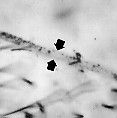If
we were to tell the life story of a piece of obsidian, one of the
millions of pieces native to California, it might go something like
this: born in a volcanic eruption, quarried and carved into a scraper
for tree bark, traded for ocean shells, chipped into an arrowhead,
lost during a deer hunt, buried by debris and sediments, dug up by an
archeologist, mailed to a laboratory for testing, and finally laid to
rest in a museum collection. That
sounds like a useful, well-traveled life.
But a short one, since its lifespan as described above could be
a mere 20,000 years or so – quite a youngster compared to most rock
and mineral specimens. Yet
few other minerals have had as much cultural, historic and scientific
importance as obsidian. The
key to obsidian’s impact lies in two factors: its homogeneity
(uniformity or sameness) and its ability to hydrate (to absorb water
from the surrounding air or soil). When
obsidian is born in a rhyolitic lava flow, where the lava cools so
fast that no crystals form, the resulting chemical composition is
homogenous across the flow.1 Every flow will contain
slightly different amounts of trace elements than every other flow, so
each flow has a chemical “fingerprint” of its own.
Two pieces of obsidian from the same flow will have identical
fingerprints, no matter how far apart they were discovered.
Obsidian “sourcing” (determining exactly where a piece of
obsidian originated) is accomplished by the use of Neutron Activation
Analysis (NAA), which bombards the specimen with a field of neutrons.
The trace elements within the sample become radioactive and the
radioactive emissions are used to identify dozens of different
elements and the amounts of each element.
Since no two flows anywhere in the world have exactly the same
trace elements in exactly the same amounts, comparing the specimen to
a database of previous specimens solves the mystery.
According to the Worcester Polytechnic Institute,
“fingerprinting of obsidian artifacts by NAA is a nearly 100 percent
successful method.”2 Obsidian
sourcing has been a primary means of determining patterns of migration
and trading among prehistoric peoples in California. If the same obsidian fingerprints exist on samples formed at
Lassen Peak and excavated near Alameda, trading surely occurred during
that 250 mile trip. People
near the coast who had no local source of obsidian often traded their
coastal treasures, such as shells, for the prized spear point and
arrowhead-making material. Just
as homogeneity has enabled us to determine the “where” in the life
of a piece of obsidian, hydration has given us clues about the
“when.” As soon as
obsidian is formed, its exposed surface begins to absorb water from
the atmosphere. The absorption continues steadily over time, dependent on
variables such as local temperature and humidity. By microscopically measuring the depth of the absorbed water
layer, called the “hydration rim,” we can determine the date of an
obsidian artifact, either relative to another artifact, or –
sometimes – with an absolute date. When obsidian is quarried or flaked in the process of becoming an artifact, new surfaces are suddenly exposed to the atmosphere, beginning new hydration processes. In our biography above, the tree bark scraper would have been hydrating longer than the arrowhead – but how would we know the true age of the artifact when different hydration depths and layers exist on the same specimen? In addition, without knowing how the climatic variables may have changed over thousands of years, the process of the hydration dating method has “major limiting problems.”2 Some of these pitfalls have given rise to wildly conflicting and controversial theories about the age of the first human settlements on our continent. A new technique called Secondary Ionization
Mass Spectrometry (SIMS) involves slowly penetrating into the obsidian
sample with an ion beam and measuring more precisely the distribution
of hydrogen (in the absorbed water), and the depth of the hydration
rim. 3 As
science develops even more sophisticated laboratory techniques and
computer models to analyze hydration variables, we will gradually be
able to refine and revise the “when” of obsidian specimens, and
then perhaps every piece of obsidian can have its own true biography. -------------------------------------------------------------------------- References: 1.
Glascock, Michael.
Archaeology, Geology, and Geochemistry of Obsidian for
Provenance Research. Oct 2002. <http://www.peak.org/obsidian/abstracts_g.html> 2.
“Neutron
Activation Analysis.” Worcester Polytechnic Institute. <http://www.wpi.edu/Academics/Depts/ME/ 3.
“The
Obsidian Clock.” Oak Ridge National Laboratory. <http://www.ornl.gov/info/reporter/no7/clock.htm>
Photo
from “Introduction to Obsidian Hydration Studies.” <http://www.obsidianlab.com/info_oh.html> |
